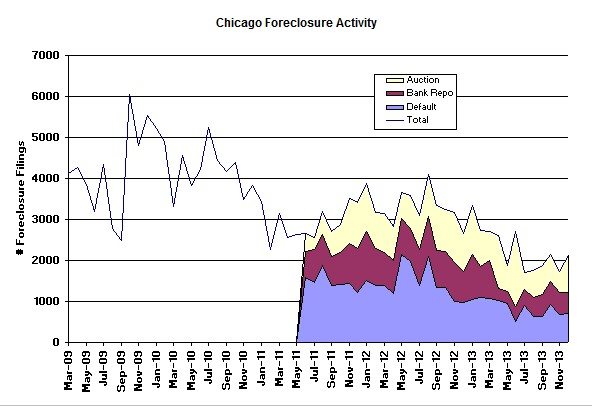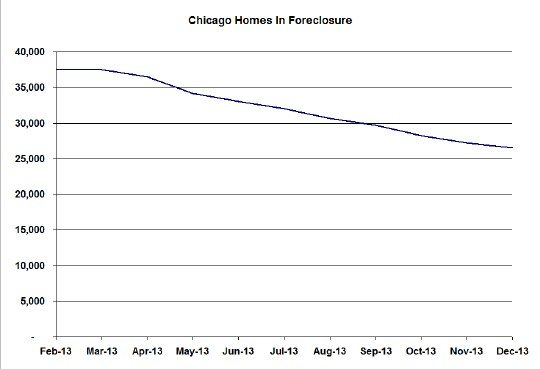Yesterday RealtyTrac released their December And Year End Foreclosure Market Report which showed that in 2013 the nation had the lowest level of foreclosure activity in the last 6 years – about half of what it was at the peak in 2010. As you can see in the graph below foreclosure activity has been steadily declining since the peak.
In discussing the national foreclosure picture, Daren Blomquist, vice president at RealtyTrac, said:
…the shadow cast by the foreclosure crisis is shrinking as fewer distressed properties enter foreclosure and properties already in foreclosure are poised to exit in greater numbers in 2014 given the greater numbers of scheduled foreclosure auctions in 2013 in judicial states — which account for the bulk of U.S. foreclosure inventory.
The push to schedule these auctions is certainly coming at an opportune time for the foreclosing lenders. There is unprecedented demand from institutional investors willing to pay with cash to buy at the foreclosure auction, helping to raise the value of properties with a foreclosure filing in 2013 by an average of 10 percent nationwide.
Looking at foreclosure activity in Chicago you can see that it has been on a decline since 2009 but has recently flattened out. In fact, over the last 5 months it looks like activity has actually picked up slightly. Some of that is due to an increase in auction activity, which is actually a good thing since this helps clear out the backlog of foreclosed properties. At the front end of the pipeline we really haven’t seen much, if any, increase in defaults, which is also good.
Chicago Shadow Inventory
Speaking of the backlog of foreclosed properties…it continues to decline, though the December numbers did not drop as much as in previous months.
The good news is that as home prices rise and people regain equity in their homes they are less likely to default – as you might expect. If you have something to lose you are going to work a lot harder to hang onto whatever you have. The Federal Reserve Bank of San Francisco published an article back in 2010 that looked at the impact of current loan to value ratios on default rates and they basically confirmed that the more equity that people have in their home the less likely they are to default. See the graph below. Duh!
However, you will also notice that as the loan to value ratio starts to go really high the default rate actually declines somewhat. The authors of the study believe that simply reflects the fact that as home prices start to fall people will default before the loan to value ratio goes too high. In other words, for the higher loan to value ratios a lot of the weak players already got out of the game.
You will also notice that they separated out mortgages originated in 2006 and those have a much higher default rate. The article really doesn’t discuss this phenomenon but it could simply be that this was the worst of the bubble and that’s when mortgage underwriting was at its weakest.
If you want to keep up to date on the Chicago real estate market, get an insider’s view of the seamy underbelly of the real estate industry, or you just think I’m the next Kurt Vonnegut you can Subscribe to Getting Real by Email. Please be sure to verify your email address when you receive the verification notice.



